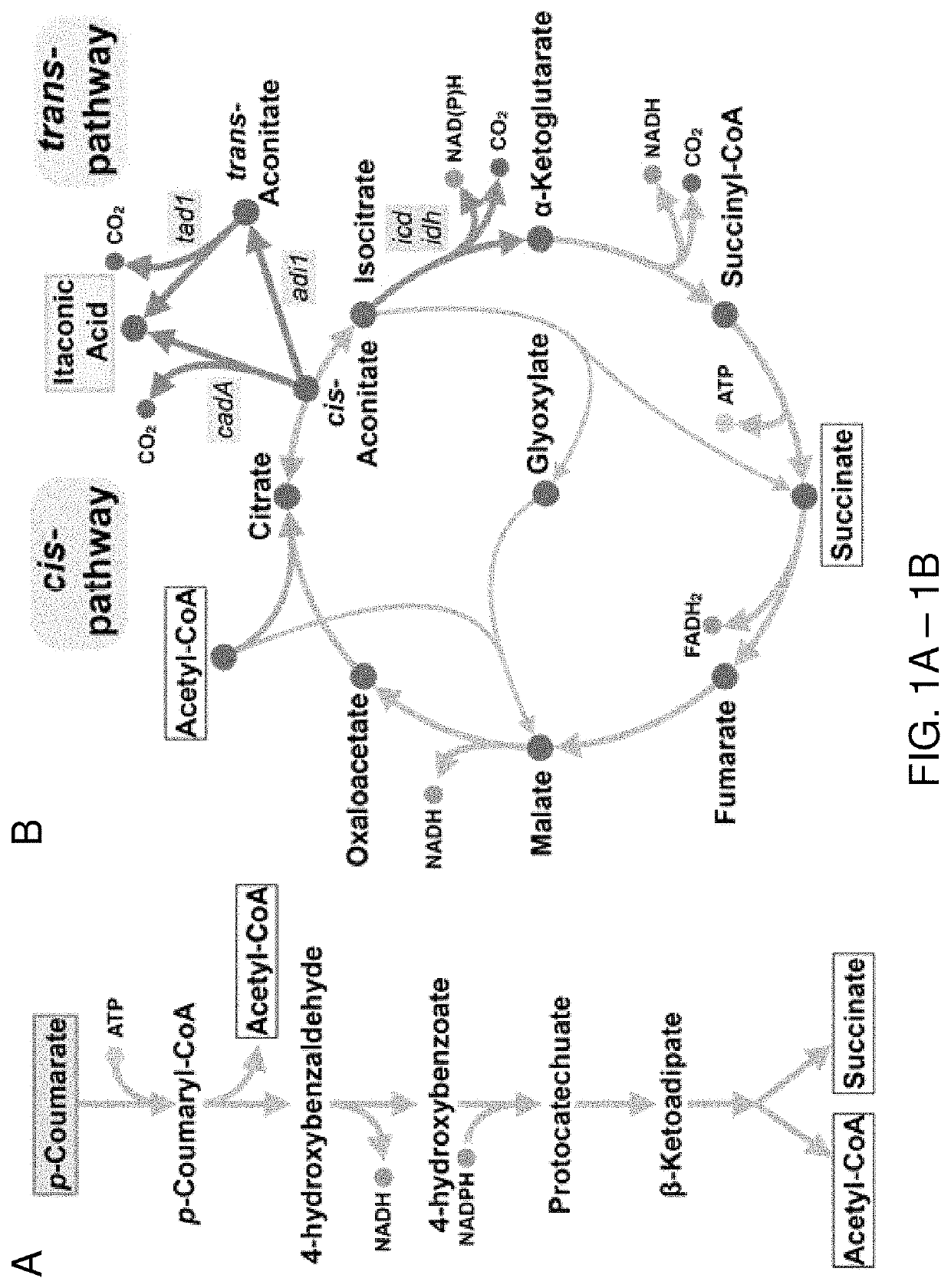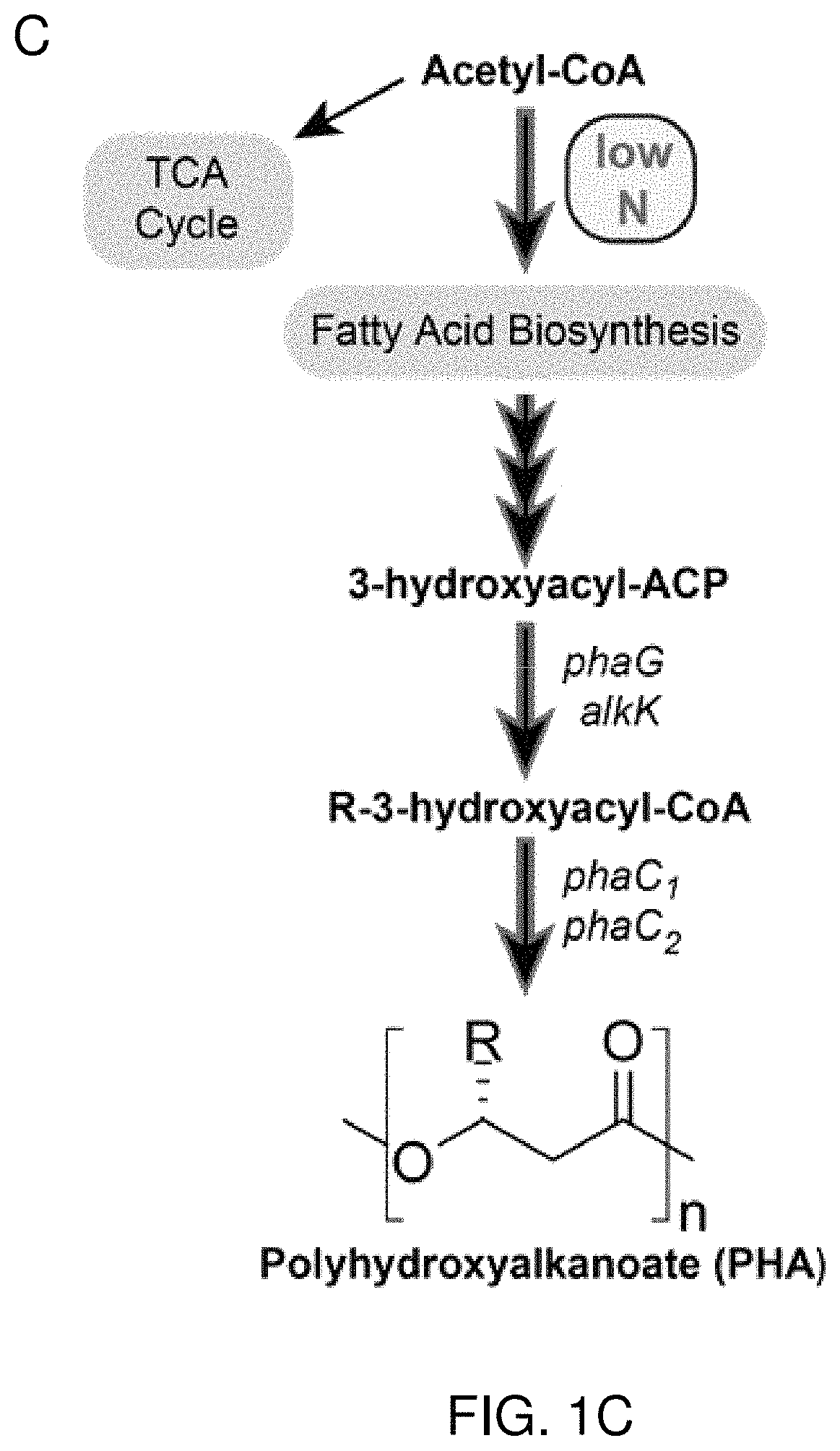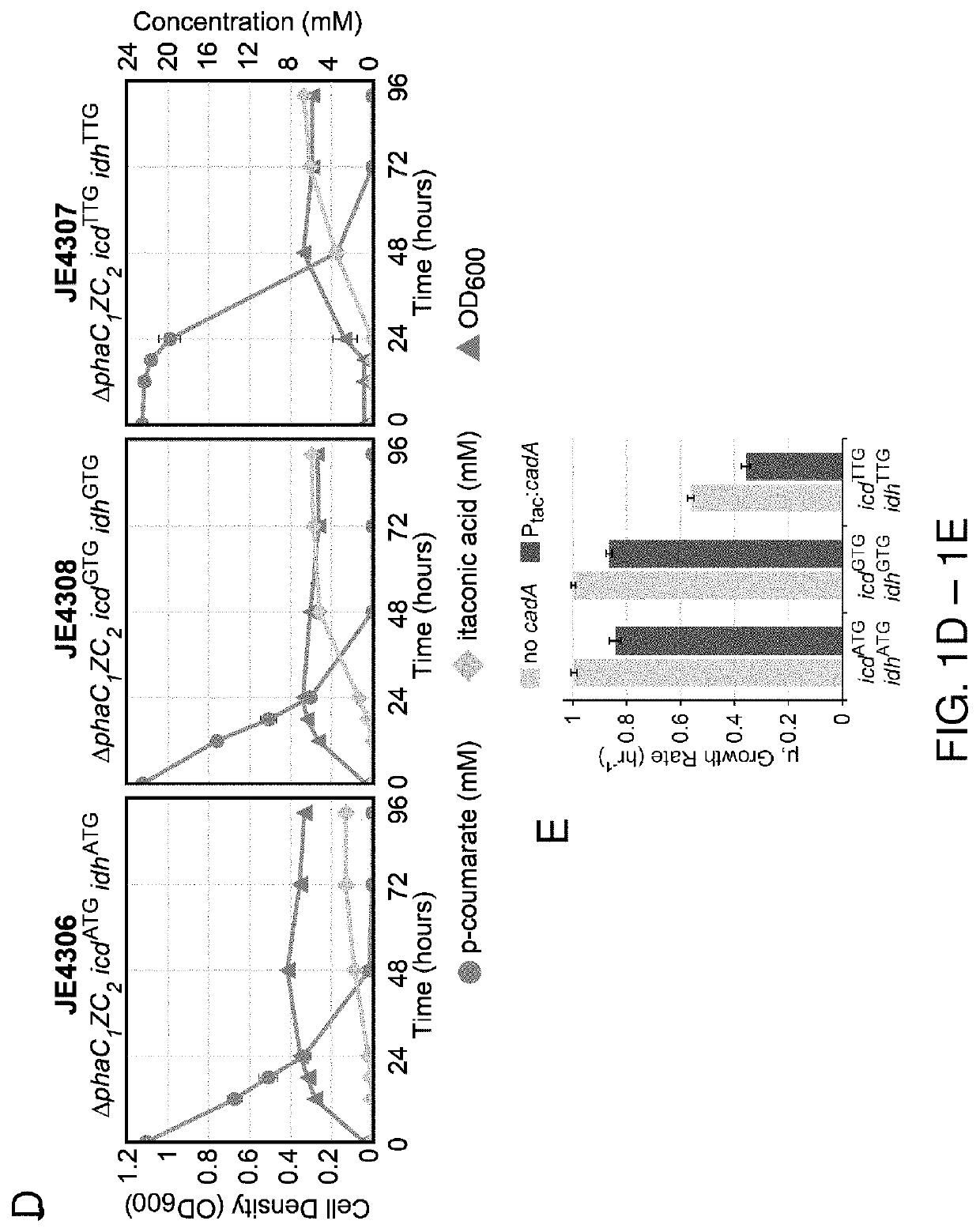Production of itaconic acid and related molecules from aromatic compounds
a technology of aromatic compounds and isocitrate dehydrogenase enzymes, which is applied in the direction of lyase, transferase, bacteria-based processes, etc., can solve the problems of under-use as a low-value heating source, the inability to use lignocellulosic residuals (i.e., lignins) constituting about 30% of the total biomass content, and the inability to achieve high-value heating sources, reducing
- Summary
- Abstract
- Description
- Claims
- Application Information
AI Technical Summary
Benefits of technology
Problems solved by technology
Method used
Image
Examples
example 1
and Methods
General Culture Conditions and Media
[0072]
TABLE 1The bacterial strains used in this study:StrainsRelevant GenotypeNEB 5-Escherichia coli F′ proA+B+ lacIq Δ(lacZ)M15 zzf::Tn10 (TetR) / alpha F′IqfhuA2Δ(argF-lacZ)U169 phoA glnV44 ΦP80Δ′lacZ)M15 gyrA96recA1 relA1 endA1 thi-1 hsdR17Epi400Escherichia coli F− mcrA Δ(mrr-hsdRMS-mcrBC) Φ80dlacZΔM15ΔlacX74 recA1 endA1 araD139 Δ(ara, leu)7697 galU galK λ−rpsL (StrR) nupG trfA tonA pcnB4 dhfrQP15Escherichia coli F′ proA+B+ lacIq Δ(lacZ)M15 zzf::Tn10 (TetR) / mcrA Δ(mrr-hsdRMS-mcrBC) Φ80dlacZΔM15 ΔlacX74 recA1endA1 araD139 Δ(ara, leu)7697 galU galK λ− rpsL (StrR) nupGtrfA tonA pcnB4 dhfrBL21 (DE3)Escherichia coli F−, ompT, hsdSB (rB−, mB−), dcm, gal, λ(DE3),pLysSpLysS, Cmr.JE90Pseudomonas putida KT2440 ΔhsdR::Bxb1int-attBJE2113P. putida KT2440 ΔhsdR::Bxb1int-attBΔampC::lysY:PurtA:T7_RNAPJE3128P. putida KT2440 ΔhsdR::Bxb1int-attL:nptII:PT7:cadA:attRΔampC::lysY:PurtA:T7_RNAPJE3215P. putida KT2440 ΔhsdR::Bxb1int-attBΔampC::lysY:PurtA:T7_RNA...
example 2
egulation Enables Two-Stage Production of Itaconate Production from Lignin-Derive Aromatics
[0111]The enzyme cis-aconitate decarboxylase produces itaconic acid (itaconate) by enzymatic decarboxylation of the TCA cycle intermediate cis-aconitate (FIG. 1B). In the fungus Aspergillus terreus, the cadA gene encodes cis-aconitate decarboxylase, and is the sole enzyme required for production of itaconate from the TCA cycle intermediate cis-aconitate. In P. putida, many aromatic compounds derived from lignin are funneled from numerous peripheral catabolic pathways into the intermediates catechol or protocatechuate, which are further metabolized by the β-ketoadipate pathway to produce an acetyl-CoA and succinate (FIG. 1A). The production of a single itaconate requires condensation of an acetyl-CoA and oxaloacetate, which is readily produced from succinate, into a citrate molecule, which can then be dehydrated to the immediate precursor cis-aconitate (FIG. 1B).
[0112]The inventors constructed ...
example 3
Pathway Selection to Optimize Itaconate Production
[0115]To date, other than in organisms that natively produce itaconate, all attempts to engineer strains for itaconate production have focused on heterologous expression the cis-aconitate decarboxylase, or cis-pathway, from A. terreus. However, an alternate pathway for itaconate production was recently discovered in Ustilago maydis (Geiser et al., Microbial Biotech., 9.1 (2016): 116-126). This pathway, referred to here as the trans-pathway, proceeds through two steps. First, cis-aconitate is isomerized to the thermodynamically favorable isomer, trans-aconitate, by aconitate isomerase (adi1, P. putida KT2440 protein sequence SEQ ID NO: 110), which is subsequently decarboxylated by trans-aconitate decarboxylase (tad1, P. putida KT2440 protein sequence SEQ ID NO: 109) generating itaconate (FIG. 1B). At equilibrium, the trans isomer comprises 88% of aconitate. Furthermore, trans-aconitate is not a substrate of aconitate hydratase, and al...
PUM
| Property | Measurement | Unit |
|---|---|---|
| time points | aaaaa | aaaaa |
| temperature | aaaaa | aaaaa |
| temperature | aaaaa | aaaaa |
Abstract
Description
Claims
Application Information
 Login to View More
Login to View More - R&D
- Intellectual Property
- Life Sciences
- Materials
- Tech Scout
- Unparalleled Data Quality
- Higher Quality Content
- 60% Fewer Hallucinations
Browse by: Latest US Patents, China's latest patents, Technical Efficacy Thesaurus, Application Domain, Technology Topic, Popular Technical Reports.
© 2025 PatSnap. All rights reserved.Legal|Privacy policy|Modern Slavery Act Transparency Statement|Sitemap|About US| Contact US: help@patsnap.com



